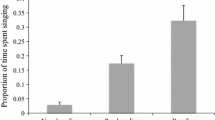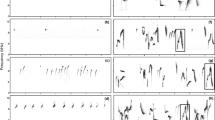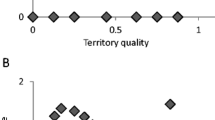Summary
The Beau Geste hypothesis proposes that song repertoires are advantageous in territory defense because nonterritorial males, who are prospecting for territories, use the number of song types they hear to assess the density of territorial males, and then avoid densely-settled areas. A territorial male can then inflate the apparent density of singers on his territory by singing several distinct song type. This hypothesis assumes (1) a positive correlation between the density of song types and the density of territorial males, and (2) a negative correlation between the rate of trespassing and the densities of both song types and territorial males. We studied the behavior of male red-winged blackbirds (Agelaius phoeniceus) and found support for the first, but not the second, assumption. Results showing a positive correlation between density of song types and density of territorial males show that the proposed method of density assessment is feasible in this species. However, we could find no support for the assumption that nonterritorial male red-winged blackbirds avoid densely settled areas. In contrast to the assumed negative correlation, rate of trespass per territory was not consistently correlated with male density, and trespass rate per unit area was positively correlated with male density. Further, these relationships were retained when we controlled statistically for the effects of territory quality. We conclude that prospecting male red-winged blackbirds to not attempt to avoid densely settled areas, and that, although they do avoid territories defended by many song types, they do not use song type density to assess the density of territorial males. It is thus unlikely that the Beau Geste hypothesis adequately accounts for the evolution of song repertoires in the red-winged blackbird.
Similar content being viewed by others
References
Barash DP (1982) Socioliology and behavior. Elsevier North-Holland, New York
Davies NB (1978) Ecological questions about territorial Behaviour. In: Krebs JR, Davies NB (eds) Behavioural ecology. Sinauer, Sunderland, Mass, pp 317–350
Dawson SM, Jenkins PF (1983) Chaffinch song repertoires and the Beau Geste hypothesis. Behaviour 87:256–269
Gould SJ, Vrba ES (1982) Exaptation — a missing term in the science of form. Paleobiology 8:4–15
Krebs JR (1976) Habituation and song repertoires in the great tit. Behav Ecol Sociobiol 1:215–227
Krebs JR (1977) The significance of song repertoires: the Beau Geste hypothesis. Anim Behav 25:475–478
Krebs JR, Ashcroft R, Webber MI (1978) Song repertoires and territory defence. Nature 271:539–542
Krebs JR, Kroodsma DE (1980) Repertoires and geographical variation in bird song. In: Rosenblatt JS, Hinde RA, Beer C, Busnel M-C (eds) Advances in the study of behavior, vol 11. Academic Press, New York, pp 143–177
Kroodsma DE (1982) Song repertoires: problems in their definition and use. In: Kroodsma DE, Miller EH (eds) Acoustic communication in birds, vol 2. Academic Press, New York, pp 125–146
MacGregor PK, Krebs JR, Perrins CM (1981) Song repertoires and lifetime reproductive success in the great tit (Parus major). Am Nat 118:149–159
Searcy WA, Marler P (1984) Interspecific differences in the response of female birds to song repertoires. Z Tierpsychol (in press)
Searcy WA, Searcy MH, Marler P (1982) The response of swamp sparrows (Melospiza georgiana) to acoustically distinct song types. Behaviour 80:70–83
Searcy WA, Yasukawa K (1983) Sexual selection and redwinged blackbirds. Am Sci 71:166–174
Slater PJB (1981) Chaffinch song repertoires: observations, experiments and a discussion of their significance. Z Tierpsychol 56:1–24
Smith DG, Reid FA (1979) Roles of the song repertoire in red-winged blackbirds. Behav Ecol Sociobiol 5:279–290
Whitney CJ (1981) Patterns of singing in the varied thrush. I. The similarity of songs within individual repertoires. Z Tierpsychol 57:131–140
Yasukawa K (1981a) Song repertoires in the red-winged blackbird (Agelaius phoeniceus): a test of the Beau Geste hypothesis. Anim Behav 29:114–125
Yasukawa K (1981b) Male quality and female choice of mate in the red-winged blackbird (Agelaius phoeniceus). Ecology 62:922–929
Yasukawa K, Blank JL, Patterson CB (1980) Song repertoires and sexual selection in the red-winged blackbird. Behav Ecol Sociobiol 7:233–238
Author information
Authors and Affiliations
Rights and permissions
About this article
Cite this article
Yasukawa, K., Searcy, W.A. Song repertoires and density assessment in red-winged blackbirds: further tests of the Beau Geste hypothesis. Behav Ecol Sociobiol 16, 171–175 (1985). https://doi.org/10.1007/BF00295152
Received:
Accepted:
Issue Date:
DOI: https://doi.org/10.1007/BF00295152




